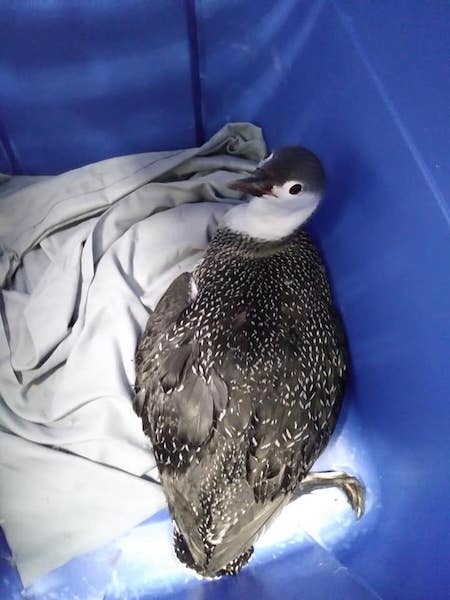| Above: A grounded loon was one of the lucky ones to be rescued by Centre Wildlife Care on December 18, 2019. Image credit: Courtesy Centre Wildlife Care, Port Matilda, Pennsylvania. |
During the morning of December 18, freezing rain produced an icy coating on trees, plants, power lines, and other untreated surfaces over central Pennsylvania.
Freezing rain was not, however, the only “icy precipitation” falling out of the sky on this day. It was also raining migratory loons. For the record, loons are aquatic Arctic birds whose “landing gears” (their feet) are not suited for touching down or taking off from land or small lakes and ponds. Indeed, Centre Wildlife Care, which serves Centre County and surrounding areas, quickly put out an alert to the general public to be on the lookout for helpless, grounded loons. Centre Wildlife Care then responded to the public responsibly reporting grounded loons in the region by taking them in and giving them temporary shelter from the freezing rain.
I’ll have more to say about the inherent danger posed to loons by land and small bodies of water in just a moment. First, I feel compelled to talk about the meteorology that led to the grounding of loons over central Pennsylvania.
The vertical profile of temperature over the region was a classic set-up for freezing rain/drizzle, as the temperature (and dew-point) model sounding over University Park indicated (see below).
As a disclaimer, professional forecasters typically present the vertical temperature structure of the troposphere by using Skew-T Log-P diagrams, but, in order to more easily convey the meteorology of freezing rain to our readers, I decided, instead, to use this rather simple linear plot.
 |
| Figure 1. The GFS model sounding at University Park, PA, at 12 UTC (7 a.m. EST). The lime-green curve corresponds to temperature (expressed in degrees Celsius), while the aqua-blue plot indicates the vertical profile of dew points (also expressed in degrees Celsius). Courtesy of NOAA and The Pennsylvania State University. |
For reference, the vertical axis represents pressure expressed in millibars, while the horizontal axis coincides with temperature, expressed in degrees Celsius. From roughly 700 mb to the ground (700 mb corresponds to an altitude of approximately 10,000 feet), the temperature (lime-green) and dew-point (aqua-blue) soundings were identical (or nearly so). Such an extensive overlap of temperature and dew point through a deep layer of air indicates the presence of precipitation. Indeed, high relative humidity (100% or slightly lower) through a deep layer of the atmosphere is a classic footprint of precipitation.
As I have written many times before, a large percentage of the precipitation falling over United States begins as snow in the typically cold, middle troposphere (yes, even during summer). Revisiting the plot of temperature and dew points over University Park, PA (above), falling snowflakes melted into raindrops in the rather thick and “warm” layer (which I annotated as the “Melting Layer”). In this melting layer, temperatures were noticeably higher than 0°C (32°F).
Closer to the ground, there was a fairly thick layer where temperatures were lower than 0°C. In this “cold” layer, raindrops became supercooled (i.e., remained unfrozen at a temperature below 0°C). As supercooled raindrops splashed down on cold surfaces at and near the ground, they froze after impact, completing the classic earthward journey of freezing rain.
 |
Migrating loons suffered a similar fate, and, as ice accumulated on their feathers and tails, the loons’ airworthiness was compromised; the weight of the ice just made it too difficult to fly. To complicate matters, icy loons apparently mistook wet roads and parking lots below their flight path as bodies of water, and so they landed.
Here’s where the plight of the loons turned from bad to worse. The feet of Arctic loons are too far back on their bodies for them to walk on land or, more critically, to take flight from land. Even small ponds or lakes are not ideal for take-off. I have read that it takes roughly 100 meters (330 feet) or so for loons to take flight from a body of water. As a result, loons typically use large lakes, bays, and coastal ocean waters during migration.
I’m obviously not a loon expert, but I surmise that placing a grounded loon in a small lake or pond would be very, very dangerous because they require a larger body of water to take flight.
The story had a happy ending for the loons taken in by Centre Wildlife Care. CWC released the rescued loons at Lake Perez later in the day. I hope they complete their migratory journey without further incident.
Centre Wildlife Care is a very special place, and my wife and I have sponsored several of the “critters” that CWC has rescued and nursed back to health.
Lee
Editor's note: Sunday morning, December 22, brought yet another example of the destructive power of icing. Dense freezing fog deposited a glaze of ice on Interstate 64 near Williamsburg, Virginia, and the fog itself (with visibility less than a quarter mile at times) hampered visibility. A resulting series of chain-reaction wrecks involved 69 vehicles and injured at least 51 people. For more on this major incident, see the weather.com writeup.




